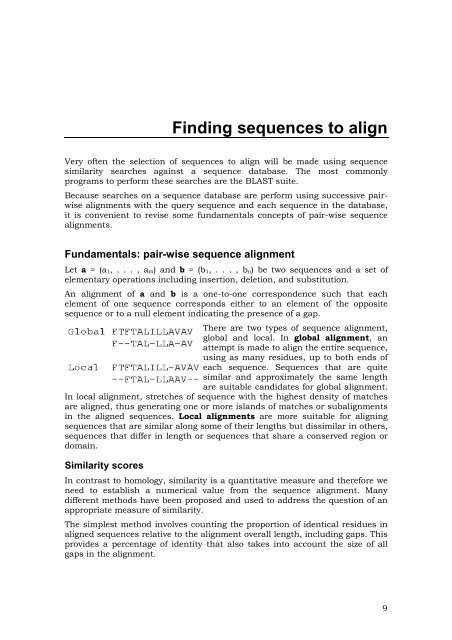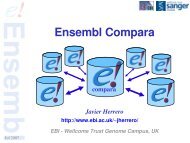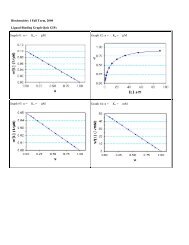Practical Course on Multiple Sequence Alignment - CNB - Protein ...
Practical Course on Multiple Sequence Alignment - CNB - Protein ...
Practical Course on Multiple Sequence Alignment - CNB - Protein ...
Create successful ePaper yourself
Turn your PDF publications into a flip-book with our unique Google optimized e-Paper software.
Finding sequences to align<br />
Very often the selecti<strong>on</strong> of sequences to align will be made using sequence<br />
similarity searches against a sequence database. The most comm<strong>on</strong>ly<br />
programs to perform these searches are the BLAST suite.<br />
Because searches <strong>on</strong> a sequence database are perform using successive pairwise<br />
alignments with the query sequence and each sequence in the database,<br />
it is c<strong>on</strong>venient to revise some fundamentals c<strong>on</strong>cepts of pair-wise sequence<br />
alignments.<br />
Fundamentals: pair-wise sequence alignment<br />
Let a = (a 1, . . . , a m) and b = (b 1, . . . , b n) be two sequences and a set of<br />
elementary operati<strong>on</strong>s including inserti<strong>on</strong>, deleti<strong>on</strong>, and substituti<strong>on</strong>.<br />
An alignment of a and b is a <strong>on</strong>e-to-<strong>on</strong>e corresp<strong>on</strong>dence such that each<br />
element of <strong>on</strong>e sequence corresp<strong>on</strong>ds either to an element of the opposite<br />
sequence or to a null element indicating the presence of a gap.<br />
There are two types of sequence alignment,<br />
global and local. In global alignment, an<br />
attempt is made to align the entire sequence,<br />
using as many residues, up to both ends of<br />
each sequence. <strong>Sequence</strong>s that are quite<br />
similar and approximately the same length<br />
are suitable candidates for global alignment.<br />
In local alignment, stretches of sequence with the highest density of matches<br />
are aligned, thus generating <strong>on</strong>e or more islands of matches or subalignments<br />
in the aligned sequences. Local alignments are more suitable for aligning<br />
sequences that are similar al<strong>on</strong>g some of their lengths but dissimilar in others,<br />
sequences that differ in length or sequences that share a c<strong>on</strong>served regi<strong>on</strong> or<br />
domain.<br />
Similarity scores<br />
In c<strong>on</strong>trast to homology, similarity is a quantitative measure and therefore we<br />
need to establish a numerical value from the sequence alignment. Many<br />
different methods have been proposed and used to address the questi<strong>on</strong> of an<br />
appropriate measure of similarity.<br />
The simplest method involves counting the proporti<strong>on</strong> of identical residues in<br />
aligned sequences relative to the alignment overall length, including gaps. This<br />
provides a percentage of identity that also takes into account the size of all<br />
gaps in the alignment.<br />
9
















